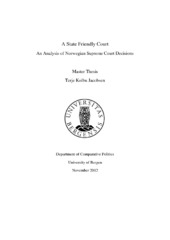| dc.description.abstract | The aim of this thesis is to test the state friendly hypothesis by comparing and integrating three different approaches to the study of judicial behavior in a hierarchical regression analysis. Decisions of the Norwegian Supreme Court in civil cases tend to favor the state over private party litigants. Acting as a court of last resort, only cases where the decision will have an impact beyond the case in question are adjudicated by the Supreme Court. By definition the sources of law do not point to a single indisputable solution in these cases. The question is whether these sources of law can be shaped to conform to a justice's desired outcome through preference initiated behavior. Based on the assumption that law is not the sole determinant of judicial decisions in the Supreme Court the following research question is established: What factors can explain the decisions of Supreme Court justices when the state is a party? Building on theoretical and analytical frameworks from the literature on judicial behavior an integrated hierarchical model based on legal factors, attitudinal factors and strategic factors is developed in the theory-section of the thesis. This is an innovation in the social-science study of judicial decisions on the Norwegian Supreme Court, which thus far has failed to account for the strategic aspects and legal aspects of judicial decision-making. Another development presented in the thesis is the introduction of multilevel analysis as an analytical tool for the study of judicial decisions. The analysis is based on a two-level hierarchical generalized linear model where judges are nested in panels. 2,217 justice-observations grouped in 445 panels are included in the analysis. Predictors are added both at level-one and level-two based on hypotheses established for each level in the hierarchical framework. The analysis identified seven significant predictors affecting the probability of voting for or against the state. Interestingly, the significant predictors included both individual-level explanatory factors and group-level explanatory factors. However, the expected relationship between a proxy for ideology and the justices' votes was not evident. The evidence supports the application of an integrated hierarchical model of judicial behavior in the analysis of judicial decisions. In unanimous decisions there is variance explained by the grouping structure in the data, which it is not possible to model in single-level analyses. Thus a hierarchical analytical framework is preferable to single-level analysis in studies including unanimous decisions. | en_US |
